Nihonbashi Revitalization Plan “Proceeding to Create While Retaining and Reviving”
1. Second Section of Nihonbashi Muromachi East District Development Project: COREDO Muromachi 2 and COREDO Muromachi 3: All 68 Stores Determined, Opening on March 20, 2014 (Thursday)
2. COREDO Muromachi and Nihonbashi Mitsui Tower: 15 Renewed Stores to Open on Same Day
November 5, 2013
Mitsui Fudosan Co., Ltd. (Project Leader)
Mitsui Fudosan Co., Ltd. is promoting the Nihonbashi Revitalization Plan, a collaborative public, private and community initiative for revitalizing and creating new appeal for the Nihonbashi area. As part of this plan, Mitsui Fudosan, together with land owners, is advancing the Nihonbashi Muromachi East District Development Project, a large-scale mixed-use redevelopment project covering 5 blocks, which combines the features of offices, retail properties, rental housing and a multi-purpose hall.
In October 2010, the Muromachi Higashi Mitsui Building (retail property name: COREDO Muromachi) was opened as the first section of Nihonbashi East Muromachi District Development Project. All 68 stores of the Muromachi Furukawa Mitsui Building (retail property name: COREDO Muromachi 2) and the Muromachi Chibagin Mitsui Building (retail property name: COREDO Muromachi 3) and their opening day (March 20, 2014) have been decided. Also renewed stores in COREDO Muromachi and Nihonbashi Mitsui Tower will open on the same day.
The Edo period saw the emergence in the Nihonbashi area of Mitsui Echigoya and several other merchant families, and confectioners for attachés to the Bakufu government. Nihonbashi was lined with markets and shops. In addition to a famed fish market and wholesalers for dried bonito flake and seaweed dealers, this retail area included theaters. The Nihonbashi area was once one of the most energetic places of its kind anywhere in the world. The current development project aims to revive this Nihonbashi energy by focusing on the streets surrounding the district and creating the lively atmosphere of a town in which it is enjoyable to stroll around by means of making their external facades based on the motif of Japanese design and by inviting traditional older shops from across Japan to open new stores in the area.
The project will include Japanese restaurants from all over Japan, stores that provide high-quality items, Nihonbashi's first cinema complex TOHO CINEMAS Nihonbashi, drinking and eating establishments that stay open late, and lifestyle-proposal general stores. In addition to Nihonbashi's traditional visitors, the project aims to provide facilities that can be enjoyed by a wide range of people, catering to the demands of office workers in the vicinity and a core target of people in their 30s and 40s. By further deepening ties among traditional older stores and department stores and by strengthening measures to attract customers throughout the area, the project will contribute to creating a livelier atmosphere in Nihonbashi.
Features of the New Facilities and the Renewed Stores
- The project's commercial business concept is “Nihonbashi - Breathing new life into Japan.” The project's 83 facilities include Japanese restaurants from all over Japan, stores that provide high-quality items, bustling drinking and eating establishments that stay open late, and lifestyle-proposal general stores.
- The streets facing the district will be lined with traditional older stores with facades based on the motifs of traditional Japanese shop curtains and lighting, making them enjoyable to stroll around in.
- Traditional older stores are opening many new business format shops (COREDO Muromachi, COREDO Muromachi 2, COREDO Muromachi 3).
- A lively zone with restaurants and food shops based on the concept of “Freshly Made Today” (COREDO Muromachi 2).
- Nihonbashi's first 9-screen approximate 1,800-seat cinema complex, TOHO CINEMAS Nihonbashi (COREDO Muromachi 2).
- Nihonbashi's first concentration of MUJI stores and new lifestyle-proposal stores (COREDO Muromachi 3).
- A new-style restaurant zone where a restaurant customer can order a dish from another restaurant's popular menu (Nihonbashi Mitsui Tower).
- A unified and spacious restaurant zone connected by a bridge to the COREDO Muromachi restaurants (COREDO Muromachi 2).
- The rustic design of the interior environment that employed the talents of Mr. Takashi Sugimoto (Super Potato Co., Ltd.) and Mr. Ryu Kosaka (A.N.D.), highlights the qualities of materials like bricks and wood.
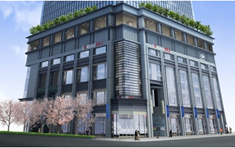 |
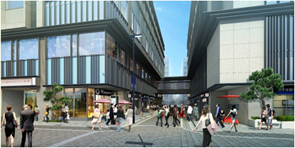 |
| Exterior view of COREDO Muromachi 3 (perspective drawing) |
Naka Dori Street (perspective drawing) |
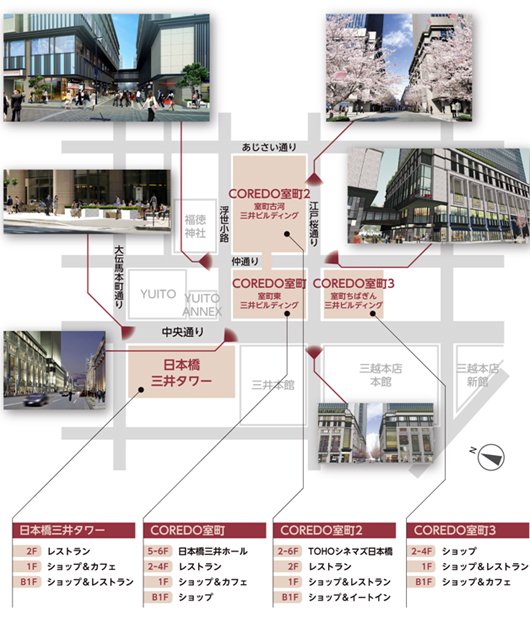
About the Nihonbashi Revitalization Plan and the Nihonbashi Muromachi East District Development Project
About the Nihonbashi Revitalization Plan
Mitsui Fudosan is promoting the Nihonbashi Revitalization Plan, a collaborative public, private and community initiative for revitalizing and creating new appeal for the Nihonbashi area based on the concept of “Proceeding to Create While Retaining and Reviving.”
The Nihonbashi Revitalization Plan began to largely swing into action due to the opportunity provided by the 2004 opening of the Mitsui Fudosan retail property COREDO Nihonbashi (Nihonbashi 1-chome Building) on the former Tokyu Department Store Nihonbashi site after the store's closure in 1999.
Concept: “Proceeding to Create While Retaining and Reviving”
Retain: Historic buildings, long-standing traditional stores, the area's culture, local communities
Revive: Streetscape and scenery, abundant waterway environment, lively atmosphere
Create: New values and urban functions, adding to the area's attractiveness by introducing smart facilities
The project will create a lively Nihonbashi that recalls its heyday as the starting point of Japan's five major highways. From reviving the waterways and conducting local beautification activities to the holding of traditional and bustling modern events, the project will work with local residents and administrations to continuously implement a variety of measures. The project will increase both the number of new visitors to Nihonbashi and make the district even more accessible and appealing to explore.
About the Nihonbashi Muromachi East District Development Project
This integrated development project, covering 5 blocks, is a large-scale mixed-use redevelopment project with gross floor space of more than 180,000 m2. The project combines features such as offices, retail properties, rental housing and a multi-purpose hall.
Measures will be implemented to improve the streetscape surrounding the district and create a lively atmosphere to develop an enjoyable town in which to stroll around.
-
The low-rise skyline facing Chuo Dori Street will be aligned at approximately 31 meters high.
-
Naka Dori Street and Ukiyo Koji Alley will see electric cables and power lines buried underground and the laying of stone pavement.
-
Edo Sakura Dori Street will see an extension of the cherry tree planting begun near the Bank of Japan, and have its sidewalks widened.
-
A lush green area called Fukutoku Forest will be developed by renovating Fukutoku Shrine and creating an approach to the shrine.
A taxi stand and bicycle/motorcycle parking lot will be developed, while parking entrances and exits will be concentrated in the Muromachi Furukawa Mitsui Building and Nihonbashi Muromachi Nomura Building, to enhance convenience for visitors to facilities, as well as safety for pedestrians.
An underpass for pedestrians will be built beneath Edo Sakura Dori Street with Chuo Ward. The underpass will be integrated with work to expand the underground area beneath Chuo Dori Street, as part of plans to develop a 3,000 m2 underground plaza. This plaza will connect directly to Tokyo Metro Mitsukoshi-mae Subway Station, JR Sobu Line Shin-Nihonbashi Station, Mitsukoshi Nihonbashi Main Store and COREDO Muromachi. In the event of a natural disaster, the plaza will also serve as an evacuation center and assist people who are unable to return home, and provide natural disaster-related information and emergency supplies, among other functions.
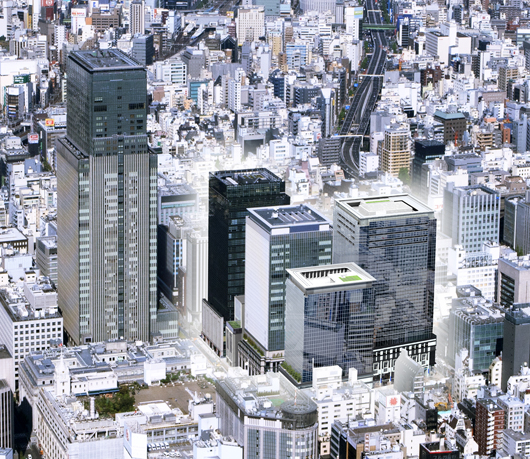
Nihonbashi Muromachi East District Development Project (perspective drawing)
Features of the New Facilities and the Renewed Stores

In the Edo period, Nihonbashi flourished as a base for commerce, distribution, finance and entertainment. It was a kind of city in its own right at the heart of Edo (now Tokyo), which had a population far exceeding that of Paris or London. The current project will reenact the lively atmosphere of the historical Nihonbashi by opening new facilities and renewing stores. To achieve this, in addition to Nihonbashi's traditional visitors, the project aims to provide facilities that can be enjoyed by a wide range of people, catering to the demands of office workers in the vicinity and a core target of people in their 30s and 40s. Concretely, the project is committed to providing stores that make use of the history and culture of Nihonbashi in their development, and to strengthening the functions that will make a livelier atmosphere in Nihonbashi.
Providing stores that make use of the history and culture of Nihonbashi in their development
- Traditional long-standing stores develop new-type stores, while making use of tradition's good points.
- Provide restaurants and food and goods shops that offer delicious items from all over Japan.
- Provide stores that offer “Made in Japan” goods and sundries, and that convey the good qualities of the materials and the high-quality of the creativity.
Strengthening the functions that will make a livelier atmosphere in Nihonbashi
- Restaurants that remain open on Saturday and Sunday, and late at night
- Lifestyle-proposal general stores
- TOHO CINEMAS Nihonbashi, the first cinema complex in the Nihonbashi area

In this project, which is the first whole-block urban renewal project in the Nihonbashi Muromachi area, measures will be implemented to improve the streetscape surrounding the district and introduce stores that will create the energy of a bustling town in which it is enjoyable to stroll around.
- The lower facades of the buildings along Chuo Dori Street will be aligned with a skyline that is approximately 31 meters high to harmonize with the Mitsui Main Building (registered as an Important Cultural Property). As regards commercial facilities, traditional older stores will be the “face” of the main street, and Sembikiya-Sohonten and Mandarin Oriental Tokyo will provide spacious open cafes, thereby creating a lively streetscape.
- Naka Dori Street will have its electric cables and power lines buried underground and be covered with a stone pavement, and an approach to the Fukutoku Shrine will be created. The streets facing the district will be lined with traditional older stores with facades based on the motifs of traditional Japanese shop curtains and lighting, making them enjoyable to stroll around in. Among these, Nihonbashi Imoya Kinjiro will offer fried sweet-potato snacks, and gift shops such as Hakkaisan Sennen Kojiya propose ways to enjoy sake together with sweets, along with offering cosmetics and other original products, thereby reviving a romantic “alley atmosphere” in the daytime. At night, vitality will be added by dining bars that stay open until late, including the wine-bar VINOSITY maxime and CRAFT BEER MARKET (tentative name) serving, as its name suggests, the now-popular craft beer.
- Edo Sakura Dori Street will see an extension of the cherry tree planting begun near the Bank of Japan, and have its sidewalks widened. Among the retail stores flowering in harmony with the cherry trees, there will be café terraces such as N2L and CAFÉ AIMÉE VIBERT and Japanese-style dining facilities that propose new possibilities, including Ninben offering its transformed katsuo (dried bonito) dashi (stock).
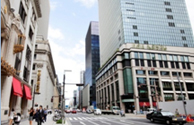 |
 |
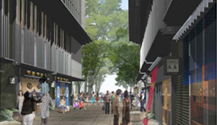 |
 |
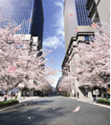 |
| Chuo Dori Street |
|
Naka Dori Street (perspective drawing) |
|
Facades of buildings along Edo Sakura Dori Street (perspective drawing)
|

COREDO Muromachi, which opened in October 2010, is home to various traditional older stores that have taken the initiative to present good traditional products in shops in a new modern manner. These include Dashiba (Bar) run by Ninben that offers drinks made from dashi (stock) made from katsuo (dried bonito), and HAKUZA NIHONBASHI that offers products that combine gold leaf, Japanese-style confectionery and cosmetics, for example.
Similarly, for COREDO Muromachi 2 and COREDO Muromachi 3 too we have proactively invited such attractive traditional older stores to open new business format shops. In more detail, these shops include Tsuruya Yoshinobu, the traditional Japanese confectionery store founded in Kyoto in 1803, where customers can now observe the skill of the maker preparing the product in front of them; Kayanoya, the old specialty dashi and seasoning store founded in 1893 that originated with a soy-sauce maker in Fukuoka; Nishiri, the traditional tsukemono (Japanese pickle) store in Kyoto that here offers a new style of cuisine that combines pickles on sushi rice, wine and tsukemono, and a specialty sukiyaki (thin slices of beef cooked at the table) restaurant run by Ningyocho Imahan, the renowned old luxury sukiyaki restaurant.

Based on the concept of “Freshly Made Today,” the first basement floor of COREDO Muromachi 2 contains a lively restaurant and food shop zone in which famous restaurants and shops enable customers to take out or eat-in the food that they have seen prepared in a kitchen before them. The zone provides many renowned and excellent food products, including at a specialty soup shop from Perignon, the famous French restaurant in the Ginza area of Tokyo; at a specialty cookie shop from Yonemura, the famous Western-style French restaurant that introduces some Kyoto cuisine to the menu; custom-made hamburgers from Nakasei, the high-quality meat restaurant in the Denenchofu area of Tokyo that is known around the world for its aged meat; and dim sum from Chungking Chinese Szechwan, the famous restaurant in Yokohama China Town. The concentration of 22 stores and restaurants also includes Riccio Mania kitchen, the specialty uni (sea urchin) restaurant from Iki Island in Nagasaki; Tsubariya, the rice-based cuisine restaurant from farmers in Uonuma in Niigata Prefecture; QJIKI, the popular specialty satsuma-age (a deep-fried patty of fish paste and vegetable bits) restaurant in Kagoshima Prefecture; the Himonomaru dried fish store from Sugamo in Tokyo which usually has a queue of customers outside; and a specialty pie store directly operated by Fujiya Hotel Hakone Miyanoshita in Hakone near Tokyo. This zone of restaurants and stores all based on “food” is home to famous restaurants from all over Japan and food shops, each of which offers products prepared in their own individual manner.

In the Edo period, Nihonbashi, which was a base for providing information about culture and entertainment, was lined with Edo kabuki theaters and joruri puppet-theaters, and a theater district grew up nearby. To recapture this bustling heyday of Nihonbashi, in October 2010 we opened the Nihonbashi Mitsui Hall in COREDO Muromachi. For the second stage of COREDO Muromachi, namely COREDO Muromachi 2, we invited TOHO CINEMAS Nihonbashi, a cinema complex that is sometimes described as the contemporary transformation of a historic local entertainment theater. This modern cinema complex has 9 screens with approximately 1,800 seats in all, and introduces such features as Tokyo's first TCX (TOHO CINEMAS EXTRA LARGE SCREEN) and the revolutionary Dolby®AtmosTM sound system that enables a three-dimensional experience. Looking ahead, the complex should set the standard for urban cinemas by providing a new level of environment for people to watch movies.
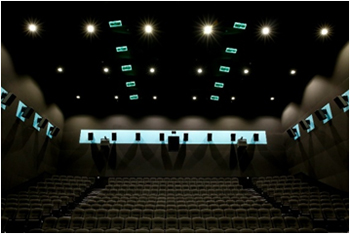
Image of the cinema

COREDO Muromachi 3's main customer target is the office workers in the vicinity and the residents of the “East Area of Tokyo” such as the Chuo and Koto wards who have been increasing in number in recent years, and the complex provides “high-quality Japanese goods” and “beautiful Japanese goods” that form part of contemporary lifestyles. Stores include MUJI, the lifestyle brand store with its simply designed goods that is also highly popular overseas (this is the first MUJI in Nihonbashi), CLASKA gallery&shop “Do,” the first store that combines a café with a new business format, and SUS gallery that was selected to provide presents for the various countries' leaders at APEC 2010. A total of 18 stores in the complex provide carefully made, excellent-quality products, and they propose new lifestyles in the areas of clothing, food and housing.

We have renewed the restaurant zone in the first basement of Nihonbashi Mitsui Tower as COREDO Muromachi Tower Dining, with the main customer target being office workers in the vicinity and visitors to the area. At dinner time we have introduced the new service initiative by which a restaurant customer when making an order can also order a dish from another restaurant's popular menu. We have designed the corridors to look like the old alleys of Nihonbashi, and have worked to create a unified and very spacious area (with approximately 220 seats) by keeping to a minimum the boundary walls between adjacent restaurants and between restaurants and corridors. We have also devised the tenant composition: in the daytime customers can eat at THE BEAT DINER to speedily sit down to an authentic American grill or hamburger, or at Tori-ryori Chokotto Ryori Hokkoriya which provides such dishes as oyako-don (a bowl of rice topped with boiled chicken and eggs) and tori-ramen (chicken noodles). For the evening, we invited such informal but well-established restaurants as the popular Kamatake-style Udon Chotto Ippai from Osaka where it offers kushiage (deep-fried skewers) and oden (Japanese-style hot pot dishes).

There is a bridge that connects the second floor of COREDO Muromachi to the cinema complex and the restaurant zone of COREDO Muromachi 2. This restaurant zone contains casual restaurants that people can drop into in an informal manner on their way home from work, places where people can arrange to meet before going into the cinema or have something light to eat, and places where they can eat or drink after the cinema while enjoying the afterglow of the movie they have just seen. The first commercial facility to open in the zone was Okiya, a famous teppanyaki griddle restaurant with whole cuts of steak known as Ayers Rock. Other much-talked-about restaurants in the zone include Beer Café Brugse Zot, run by World Liquor Importers that opened and operates the World Beer Museum, and YAMAYA, with its popular all-you-can-eat mentaiko seasoned cod roe lunches.
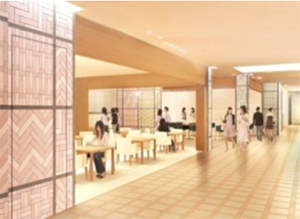

Following on from COREDO Muromachi, The design of the interior environment of COREDO Muromachi 2 was entrusted to Super Potato Co., Ltd., a design firm led by Mr. Takashi Sugimoto who was responsible for projects that include luxury hotels like the Park Hyatt Seoul and Hyatt Regency Kyoto, and expresses the atmosphere found in traditional tea-ceremony rooms and old Japanese houses. The rustic design uses materials like bricks and trees, and expresses the culture and traditions of Japan while conveying a modern sense of sturdiness. COREDO Muromachi 3 employed the talents of Mr. Ryu Kosaka of A.N.D. (AOYAMA NOMURA DESIGN) who was involved in such projects as the Mandarin Oriental Hotel Tokyo Main Dining and the W HOTEL Guanzhou Fei Ultra Lounge, and the design of this space is based on the concept of “the rhythm of the streets.” In the Edo period, Nihonbashi Dori Street (now known as Chuo Dori Street), which was described in the picture scroll Kidaishoran, was lined with large stores, and the streetscape comprised distinctive shop exteriors, shop-entrance curtains, and shop interiors. The contemporary COREDO Muromachi 3 has been reconstructed following Mr. Kosaka's new design to echo the comfortable rhythm and vibrancy of the historic Nihonbashi Dori Street using materials that are familiar to Japanese as typifying Japanese culture and traditions.
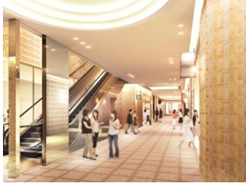
Interior view of COREDO Muromachi 2 (perspective drawing) |
 |
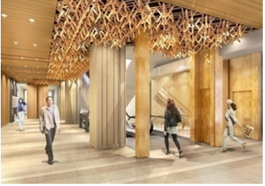
Interior view of COREDO Muromachi 3 (perspective drawing) |